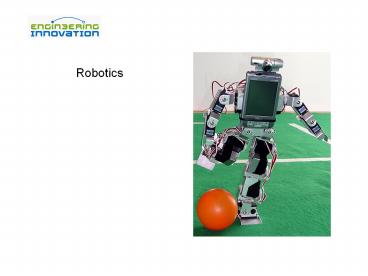Robotics - PowerPoint PPT Presentation
Title:
Robotics
Description:
2D motion = 3 degrees of freedom: 2 translation, 1 rotation ... prismatic sliding joint, e.g., square cylinder in square tube. revolute hinge joint ... – PowerPoint PPT presentation
Number of Views:297
Avg rating:3.0/5.0
Title: Robotics
1
Robotics
2
Robot coined by Karel Capek in a 1921
science-fiction Czech play
3
A robot is a reprogrammable, multifunctional
manipulator designed to move material, parts,
tools, or specialized devices through variable
programmed motions for the performance of a
variety of tasks. (Robot Institute of America)
Definition
Alternate definition
A robot is a one-armed, blind idiot with
limited memory and which cannot speak, see, or
hear.
MITs Kismet a robot which exhibits
expressions, e.g., happy, sad, surprise,
disgust.
4
Ideal Tasks
- Tasks which are
- Dangerous
- Space exploration
- chemical spill cleanup
- disarming bombs
- disaster cleanup
- Boring and/or repetitive
- Welding car frames
- part pick and place
- manufacturing parts.
- High precision or high speed
- Electronics testing
- Surgery
- precision machining.
5
Automation vs. robots
- Automation Machinery designed to carry out a
specific task - Bottling machine
- Dishwasher
- Paint sprayer
- Robots machinery designed
- to carry out a variety of tasks
- Pick and place arms
- Mobile robots
- Computer Numerical Control
- machines
(These are always better than robots, because
they can be optimally designed for a particular
task).
6
Types of robots
- Pick and place
- Moves items between points
- Continuous path control
- Moves along a programmable path
- Sensory
- Employs sensors for feedback
A SCARA robot (Selective Compliant Articulated
Robot Arm) A pick-and-place robot with
angular x-y-z positioning (Adept Technology)
A six-axis industrial robot (60K)(Fanuc
Robotics), but an additional 200K is often spent
for tooling and programming.
7
Pick and Place
- Moves items from one point to another
- Does not need to follow a specific path between
points - Uses include loading and unloading machines,
placing components on circuit boards, and moving
parts off conveyor belts.
A cartesian robot for picking and placing
circuits on circuit-boards
8
Continuous path control
- Moves along a specific path
- Uses include welding, cutting, machining parts.
Robotic seam welding
9
Sensory
- Uses sensors for feedback.
- Closed-loop robots use sensors in conjunction
with actuators to gain higher accuracy servo
motors. - Uses include mobile robotics, telepresence,
search and rescue, pick and place with machine
vision.
10
Measures of performance
- Working volume
- The space within which the robot operates.
- Larger volume costs more but can increase the
capabilities of a robot - Speed and acceleration
- Faster speed often reduces resolution or
increases cost - Varies depending on position, load.
- Speed can be limited by the task the robot
performs (welding, cutting) - Resolution
- Often a speed tradeoff
- The smallest step the robot can take
11
Performance (cont.)
- Accuracy
- The difference between the actual position of the
robot and the programmed position - Repeatability
- Will the robot always return to the same point
under the same control conditions? - Increased cost
- Varies depending on position, load
12
Control
- Open loop, i.e., no feedback, deterministic
- Closed loop, i.e., feedback, maybe a sense of
- touch and/or vision
13
Kinematics and dynamics
- Degrees of freedomnumber of independent motions
- Translation--3 independent directions
- Rotation-- 3 independent axes
- 2D motion 3 degrees of freedom 2 translation,
1 rotation - 3D motion 6 degrees of freedom 3
translation, 3 rotation
14
Kinematics and dynamics (cont.)
- Actions
- Simple joints
- prismaticsliding joint, e.g., square cylinder in
square tube - revolutehinge joint
- Compound joints
- ball and socket 3 revolute joints
- round cylinder in tube 1 prismatic, 1 revolute
- Mobility
- Wheels
- multipedal (multi-legged with a sequence of
actions)
15
Kinematics and dynamics (cont.)
- Work areas
- rectangular (x,y,z)
- cylindrical (r,?,z)
- spherical (r,?,?)
- Coordinates
- World coordinate frame
- End effector frame
- How to get from coordinate system x to x to x
16
Transformations
- General coordinate transformation from x to x
is x Bx p , where B is a rotation matrix and
p is a translation vector - More conveniently, one can create an augmented
matrix - which allows the above equation to be
expressed as x A x. - Coordinate transformations of multilink systems
are represented as - x0 A01 A12A23. . .A(n-1)(n)xn
17
Dynamics
- Velocity, acceleration of end actuator
- power transmission
- actuator
- solenoid two positions , e.g., in, out
- motorgears, belts, screws, leverscontinuum of
positions - stepper motorrange of positions in discrete
increments
18
Problems
- Joint play, compounded through N joints
- Accelerating masses produce vibration, elastic
deformations in links - Torques, stresses transmitted depending on end
actuator loads
19
Control and Programming
- Position of end actuator
- multiple solutions
- Trajectory of end actuatorhow to get end
actuator from point A to B - programming for coordinated motion of each link
- problemsometimes no closed-form solution
20
A 2-D binary robot segment
- Example of a 2D robotic link having three
solenoids to determine geometry. All members are
linked by pin joints members A,B,C have two
statesin, outcontrolled by in-line solenoids.
Note that the geometry of such a link can be
represented in terms of three binary digits
corresponding to the states of A,B,C, e.g., 010
represents A,C in, B out. Links can be chained
together and controlled by sets of three bit
codes.
21
Feedback control
- Rotation encoders
- Cameras
- Pressure sensors
- Temperature sensors
- Limit switches
- Optical sensors
- Sonar
22
New directions
- Haptics--tactile sensing
- Other kinematic mechanisms,
- e.g. snake motion
- Robots that can learn
A snake robot (OCRobotics)































